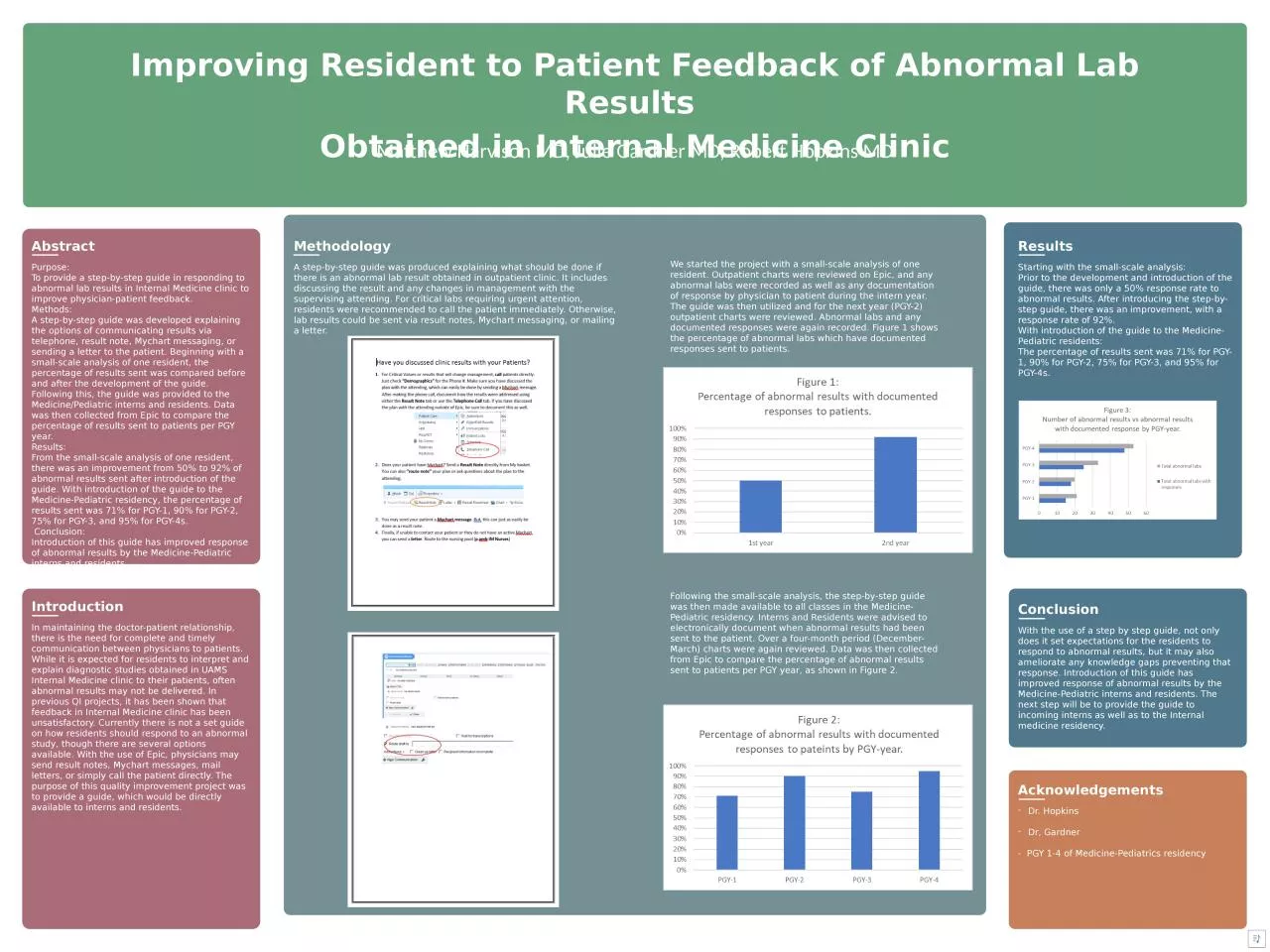

Methods A stepbystep guide was developed explaining the options of communicating results via telephone result note Mychart messaging or sending a letter to the patient Beginning with a smallscale analysis of one resident the percentage of results sent was compared before and after the ID: 1032042
Download Presentation The PPT/PDF document "Abstract Purpose: To provide a step-by-s..." is the property of its rightful owner. Permission is granted to download and print the materials on this web site for personal, non-commercial use only, and to display it on your personal computer provided you do not modify the materials and that you retain all copyright notices contained in the materials. By downloading content from our website, you accept the terms of this agreement.
1. AbstractPurpose:To provide a step-by-step guide in responding to abnormal lab results in Internal Medicine clinic to improve physician-patient feedback. Methods:A step-by-step guide was developed explaining the options of communicating results via telephone, result note, Mychart messaging, or sending a letter to the patient. Beginning with a small-scale analysis of one resident, the percentage of results sent was compared before and after the development of the guide. Following this, the guide was provided to the Medicine/Pediatric interns and residents. Data was then collected from Epic to compare the percentage of results sent to patients per PGY year. Results:From the small-scale analysis of one resident, there was an improvement from 50% to 92% of abnormal results sent after introduction of the guide. With introduction of the guide to the Medicine-Pediatric residency, the percentage of results sent was 71% for PGY-1, 90% for PGY-2, 75% for PGY-3, and 95% for PGY-4s. Conclusion:Introduction of this guide has improved response of abnormal results by the Medicine-Pediatric interns and residents. Improving Resident to Patient Feedback of Abnormal Lab Results Obtained in Internal Medicine ClinicMatthew Harvison MD, Julie Gardner MD, Robert Hopkins MDIntroductionIn maintaining the doctor-patient relationship, there is the need for complete and timely communication between physicians to patients. While it is expected for residents to interpret and explain diagnostic studies obtained in UAMS Internal Medicine clinic to their patients, often abnormal results may not be delivered. In previous QI projects, it has been shown that feedback in Internal Medicine clinic has been unsatisfactory. Currently there is not a set guide on how residents should respond to an abnormal study, though there are several options available. With the use of Epic, physicians may send result notes, Mychart messages, mail letters, or simply call the patient directly. The purpose of this quality improvement project was to provide a guide, which would be directly available to interns and residents.MethodologyA step-by-step guide was produced explaining what should be done if there is an abnormal lab result obtained in outpatient clinic. It includes discussing the result and any changes in management with the supervising attending. For critical labs requiring urgent attention, residents were recommended to call the patient immediately. Otherwise, lab results could be sent via result notes, Mychart messaging, or mailing a letter. ResultsStarting with the small-scale analysis: Prior to the development and introduction of the guide, there was only a 50% response rate to abnormal results. After introducing the step-by-step guide, there was an improvement, with a response rate of 92%.With introduction of the guide to the Medicine-Pediatric residents: The percentage of results sent was 71% for PGY-1, 90% for PGY-2, 75% for PGY-3, and 95% for PGY-4s. ConclusionWith the use of a step by step guide, not only does it set expectations for the residents to respond to abnormal results, but it may also ameliorate any knowledge gaps preventing that response. Introduction of this guide has improved response of abnormal results by the Medicine-Pediatric interns and residents. The next step will be to provide the guide to incoming interns as well as to the Internal medicine residency. AcknowledgementsDr. HopkinsDr, Gardner- PGY 1-4 of Medicine-Pediatrics residencyFollowing the small-scale analysis, the step-by-step guide was then made available to all classes in the Medicine-Pediatric residency. Interns and Residents were advised to electronically document when abnormal results had been sent to the patient. Over a four-month period (December-March) charts were again reviewed. Data was then collected from Epic to compare the percentage of abnormal results sent to patients per PGY year, as shown in Figure 2. We started the project with a small-scale analysis of one resident. Outpatient charts were reviewed on Epic, and any abnormal labs were recorded as well as any documentation of response by physician to patient during the intern year. The guide was then utilized and for the next year (PGY-2) outpatient charts were reviewed. Abnormal labs and any documented responses were again recorded. Figure 1 shows the percentage of abnormal labs which have documented responses sent to patients.